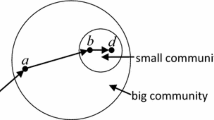Abstract
The routing is one of the key problems in delay tolerant networks (DTNs) because the source and destination often could not find a contemporaneous end-to-end path. In this paper, with the objective of reducing the number of copies, we propose two corresponding routings including a memory forwarding algorithm (MFA) and an extended memory forwarding algorithm (EMFA) for the specific type of node placement in DTNs where the nodes are randomly located and moved at different communities. The main idea of our algorithms are that the node copies a packet to an encountering node or not based on the relationship of their and the destination’s community locations calculated from the memory table, and they are designed for small and moderate number of communities respectively. We then state and analyze the expected number of copies of our algorithms. Simulation results reveal that MFA and EMFA can apparently decrease the number of copies and achieve comparable delivery delays compared with the classic multi-copy routings.








Similar content being viewed by others
References
Fall, K. (2003). A delay-tolerant network architecture for challenged Internets. In Proceedings of the ACM special interest group on data communication, pp. 27–34.
Pentland, A., Fletcher, R., & Hasson, A. (2004). Daknet: Rethinking connectivity in developing nations. Computer, 37(1), 78–83.
Burgess, J., Gallagher, B., Jensen, D., & Levine, B. N. (2006). Maxprop: Routing for vehicle-based disruption-tolerant networks. In Proceedings of the IEEE international conference on computer communications, pp. 1–11.
Segui, J., Jennings, E., & Burleigh S. (2011). Enhancing contact graph routing for delay tolerant space networking. In Proceedings of the IEEE global telecommunications conference, pp. 1–6.
Ribeiro, F. J. L., Pedroza, A. D. C. P., & Costa, L. H. M. K. (2012). Deepwater monitoring system in underwater delay/disruption tolerant network. IEEE Latin America Transactions, 10(1), 1125–1134.
Spyropoulos, T., Psounis, K., & Raghavendra, C. S. (2008). Efficient routing in intermittently connected mobile networks: The multiple-copy case. IEEE/ACM Transaction on Networking, 16(1), 77–90.
Jones, E. P. C., Li, L., & Ward, P. A. S. (2007). Practical routing in delay-tolerant networks. IEEE Transaction on Mobile Computing, 6(8), 943–959.
Acer, U., Giaccone, P., Hay, D., Neglia, G., & Tarapiah, S. (2011). Timely data delivery in a realistic bus network. In Proceedings of the IEEE international conference on computer communications, pp. 446–450.
Vahdat, A., & Becker, D. (2000). Epidemic routing for partially-connected ad hoc networks. Technical report, Duke CS-200006, Duke University.
Haas, Z. J., & Small, T. (2006). A new networking model for biological applications of ad hoc networks. IEEE/ACM Transaction on Networking, 14(1), 27–40.
Zhang, J., & Luo, G. (2012). Adaptive spraying for routing in delay tolerant networks. Wireless Personal Communications, 66(1), 217–233.
Lindgren, A., Doria, A., & Schelen, O. (2003). Probabilistic routing in intermittently connected networks. ACM SIGMOBILE Mobile Computing and Communications Review, 7(3), 239–254.
Balasubramanian, A., Levine, B. N., & Venkataramani, A. (2007). DTN routing as a resource allocation problem. In Proceedings of the ACM special interest group on data communication, pp. 373–384.
Mtibaa, A., May, M., Diot, C., & Ammar, M. (2010). PeopleRank: Social opportunistic forwarding. In Proceedings of the IEEE international conference on computer communications, pp. 1–5.
Wu, J., & Wang, Y. (2012). Social feature-based multi-path routing in delay tolerant networks. In Proceedings of the IEEE international conference on computer communications, pp. 1368–1376.
Chaintreau, A., Hui, P., Crowcroft, J., Diot, C., Gass, R., & Scott, J. (2007). Impact of human mobility on the design of opportunistic forwarding algorithms. IEEE Transaction on Mobile Computing, 6(6), 606–620.
Nain, P., Towsley, D., Liu, B., & Liu, Z. (2005). Properties of random direction models. In Proceedings of the IEEE international conference on computer communications, pp. 1897–1907.
Acknowledgments
This work is supported by Anhui Natural Science Foundation, China [1208085MF89, 1308085MF87], Open Fund of State Key Lab. for Novel Software Technology, Nanjing University, China [KFKT2011B18], SRF for ROCS, SEM [2013JYLH0280], and the Fundamental Research Funds for the Central Universities [2013HGXJ0232, 2013HGXJ0233].
Author information
Authors and Affiliations
Corresponding author
Rights and permissions
About this article
Cite this article
Wang, Q., Wang, Q. Memory Forwarding Algorithm in Multiple Communities Delay Tolerant Networks. Wireless Pers Commun 74, 703–715 (2014). https://doi.org/10.1007/s11277-013-1315-5
Published:
Issue Date:
DOI: https://doi.org/10.1007/s11277-013-1315-5




